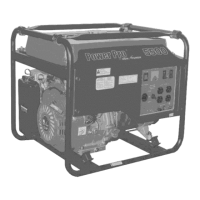SOME NOTES ABOUT POWER CORDS
Long or thin cords can drain the power provided to an electrical device by the generator.
When using such cords, allow tbr a slightly higher rated wattage requirement by the
electrical device. See Figure 12 ff_r recommended cords based on the power requirement
of the electrical device.
Device Requirements
Amps Watts (t20V)
2.5 300
5 600
7.5 900
10 1200
15 1800
20 2400
25 3000
30 3600
40 4800
*NR= not recommended
Max. Cord Length (it)
Watts(240 V) #8 wire
600 NR
1200 NR
1800 NR
2400 NR
3600 NR
4800 175
6000 150
7200 125
9600 90
#10 wire #12 wire
1000 600
500 300
350 200
250 150
150 100
125 75
100 60
65 NR
NR NR
by Wire Gauge
#14 wire #16 wire
375 250
200 125
125 100
100 50
65 NR
50 NR
NR NR
NR NR
NR NR
Figure 10- Maximum Extension (ord Lengths by Power Requirement
DCUsage
CAUTION: The DC receptacle is for recharging 12 Volt automotive-type batteries
only. Do not connect any other device to this receptacle.
CAUTION: Use the generator only to recharge 12 Volt batteries. Never try to
jumpstart a car with your generator.
To connect 12 Volt batteries to the DC receptacle:
1. Connect the positive (+) battery cable to the positive (+) terminal.
2. Connect the other end of the positive (+) battery cable to the generator.
3. Connect the negative (-) battery cable to the battery negative (-) terminal.
4. Connect the other end of the negative (-) battery cable to the generator's negative
(-) terminal.
5. Start the generator.
6. When disconnecting, always disconnect the wires from the generator first to avoid
a spark.
NOTE: If the DC terminal becomes overloaded, the DC circuit protector will switch
offand the power to this terminal will be cut. If this happens, check the Amperage of
the load you are connecting. Press the DC circuit protector button to restart the power
to this terminal.
17

